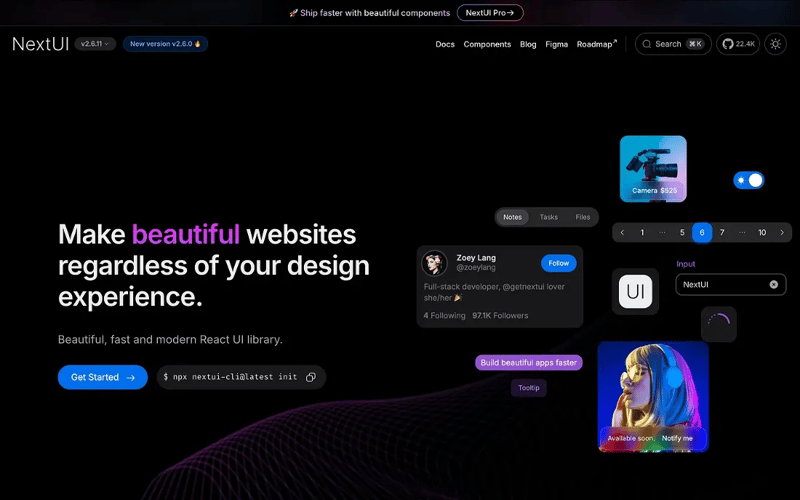Top 7 Copy-and-Paste UI Component Libraries for 2025
We've rigorously tested numerous copy-and-paste UI component libraries and selected our top seven for 2025. These libraries excel in ease of use, flexibility, scalability, customization, and built-in animations. Ready to revolutionize your design workflow? These libraries provide everything you need for sleek, modern interfaces.

1. DaisyUI: Your Tailwind CSS Design System

DaisyUI, a versatile open-source library, transforms Tailwind CSS into a comprehensive design system. It boasts pre-styled components and themes for effortless design implementation.
Key Features:
- Built-in Themes: Rapid style adaptation.
- Ready-Made Components: Buttons, modals, forms, and more are readily available.
- Customizable: Tailor designs using Tailwind's utility classes.
Ideal For: Responsive layouts, dark mode integration, and UI element customization—perfect for blogs and simple web apps. DaisyUI simplifies design without compromising quality.
2. UIverse: The Pinterest of UI Components

UIverse provides a Pinterest-like experience for discovering UI components. It offers beautifully designed, ready-to-use elements, including glowing buttons and stylish progress bars.
Key Features:
- Curated Components: A handpicked selection of visually appealing UI elements.
- Eye-Catching Effects: Floating cards, hover effects, and glowing buttons for a modern aesthetic.
- Quick Setup: Simply copy and paste—no complex setup required.
Ideal For: Visually stunning dashboards and applications where aesthetics are paramount, such as project management tools. UIverse adds polish and style with minimal effort.
3. Float UI: Simplicity and Functionality

Float UI prioritizes simplicity and functionality. This free UI library offers pre-designed components, from hero sections to pricing tables, saving you valuable time and effort.
Key Features:
- Time-Saving: Ready-made, fully styled components.
- Minimalistic Design: Clean, modern UI elements without unnecessary clutter.
- Customizable: Easily tweak with Tailwind CSS to match your brand.
Ideal For: Launching SaaS products or creating elegant landing pages. Float UI's pre-designed elements allow for rapid professional page creation, while Tailwind enables seamless brand customization.
4. Shadcn UI: The Customizable Foundation

Shadcn UI, often hailed as a top choice, is built on Radix and Tailwind CSS, emphasizing scalability and complete customization.
Key Features:
- Scalable & Customizable: Perfect for building bespoke UI libraries.
- Accessibility-Focused: Pre-designed, accessible modals, buttons, and more.
- Tailwind-Friendly: Effortless integration with Tailwind CSS for styling.
Ideal For: Creating custom component libraries for large-scale projects, such as e-commerce platforms. Shadcn UI allows for the development of accessible, reusable components that scale with your project's growth.
5. Aceternity: Animation and Visual Flair

Aceternity seamlessly integrates with Framer Motion to provide beautifully animated components, adding visual dynamism to your projects.
Key Features:
- Visually Stunning: Polished animations and effects for an enhanced user experience.
- Animation-Focused: Ideal for creating engaging, interactive elements.
- Seamless Integration: Works smoothly with Framer Motion for fluid animations.
Ideal For: Enhancing product marketing pages or startup websites. Aceternity's animated elements create a captivating user experience.
6. Magic UI: Adding Spice to Your Website

Magic UI, built on ShadCN, offers over 50 animated components to elevate your designs.
Key Features:
- Highly Animated: Over-the-top 3D effects and interactive components.
- Creative Flair: Adds a "wow" factor with unique animations.
- Pre-Assembled Templates: Magic UI Pro includes stunning, ready-to-use templates.
Ideal For: Creative portfolios and dynamic SaaS landing pages. Magic UI's animations create a memorable user experience.
7. Next UI: A Comprehensive Design System

Next UI is a complete design system, not just a component library. Built for Next.js, it provides over 210 plug-and-play components for creating polished, scalable applications.
Key Features:
- Full Design System: Includes tools for both design and development.
- Optimized for Next.js: Seamless integration and server-side rendering for high performance.
- Comprehensive Components: Forms, data tables, modals, navigation bars, and more.
Ideal For: Developing large-scale applications like enterprise dashboards. Next UI's responsive components and Figma kit facilitate efficient collaboration between developers and designers.
Choosing the Right Library
Selecting the ideal library depends on project size, design requirements, and framework compatibility. Consider the following:
- Project Size: Smaller projects benefit from libraries like Float UI and Aceternity, while larger projects require scalable systems like Next UI.
- Design Requirements: Choose Aceternity or Magic UI for animations; DaisyUI or UIverse for minimalist designs.
- Framework Compatibility: Ensure compatibility with your chosen framework (React, Vue, Svelte, or HTML).
Connect with me on LinkedIn! ?
The above is the detailed content of Top I Component Libraries for Copy, Paste, and Create!. For more information, please follow other related articles on the PHP Chinese website!

Hot AI Tools

Undress AI Tool
Undress images for free

Undresser.AI Undress
AI-powered app for creating realistic nude photos

AI Clothes Remover
Online AI tool for removing clothes from photos.

Clothoff.io
AI clothes remover

Video Face Swap
Swap faces in any video effortlessly with our completely free AI face swap tool!

Hot Article

Hot Tools

Notepad++7.3.1
Easy-to-use and free code editor

SublimeText3 Chinese version
Chinese version, very easy to use

Zend Studio 13.0.1
Powerful PHP integrated development environment

Dreamweaver CS6
Visual web development tools

SublimeText3 Mac version
God-level code editing software (SublimeText3)
 How to make an HTTP request in Node.js?
Jul 13, 2025 am 02:18 AM
How to make an HTTP request in Node.js?
Jul 13, 2025 am 02:18 AM
There are three common ways to initiate HTTP requests in Node.js: use built-in modules, axios, and node-fetch. 1. Use the built-in http/https module without dependencies, which is suitable for basic scenarios, but requires manual processing of data stitching and error monitoring, such as using https.get() to obtain data or send POST requests through .write(); 2.axios is a third-party library based on Promise. It has concise syntax and powerful functions, supports async/await, automatic JSON conversion, interceptor, etc. It is recommended to simplify asynchronous request operations; 3.node-fetch provides a style similar to browser fetch, based on Promise and simple syntax
 JavaScript Data Types: Primitive vs Reference
Jul 13, 2025 am 02:43 AM
JavaScript Data Types: Primitive vs Reference
Jul 13, 2025 am 02:43 AM
JavaScript data types are divided into primitive types and reference types. Primitive types include string, number, boolean, null, undefined, and symbol. The values are immutable and copies are copied when assigning values, so they do not affect each other; reference types such as objects, arrays and functions store memory addresses, and variables pointing to the same object will affect each other. Typeof and instanceof can be used to determine types, but pay attention to the historical issues of typeofnull. Understanding these two types of differences can help write more stable and reliable code.
 React vs Angular vs Vue: which js framework is best?
Jul 05, 2025 am 02:24 AM
React vs Angular vs Vue: which js framework is best?
Jul 05, 2025 am 02:24 AM
Which JavaScript framework is the best choice? The answer is to choose the most suitable one according to your needs. 1.React is flexible and free, suitable for medium and large projects that require high customization and team architecture capabilities; 2. Angular provides complete solutions, suitable for enterprise-level applications and long-term maintenance; 3. Vue is easy to use, suitable for small and medium-sized projects or rapid development. In addition, whether there is an existing technology stack, team size, project life cycle and whether SSR is needed are also important factors in choosing a framework. In short, there is no absolutely the best framework, the best choice is the one that suits your needs.
 JavaScript time object, someone builds an eactexe, faster website on Google Chrome, etc.
Jul 08, 2025 pm 02:27 PM
JavaScript time object, someone builds an eactexe, faster website on Google Chrome, etc.
Jul 08, 2025 pm 02:27 PM
Hello, JavaScript developers! Welcome to this week's JavaScript news! This week we will focus on: Oracle's trademark dispute with Deno, new JavaScript time objects are supported by browsers, Google Chrome updates, and some powerful developer tools. Let's get started! Oracle's trademark dispute with Deno Oracle's attempt to register a "JavaScript" trademark has caused controversy. Ryan Dahl, the creator of Node.js and Deno, has filed a petition to cancel the trademark, and he believes that JavaScript is an open standard and should not be used by Oracle
 What is the cache API and how is it used with Service Workers?
Jul 08, 2025 am 02:43 AM
What is the cache API and how is it used with Service Workers?
Jul 08, 2025 am 02:43 AM
CacheAPI is a tool provided by the browser to cache network requests, which is often used in conjunction with ServiceWorker to improve website performance and offline experience. 1. It allows developers to manually store resources such as scripts, style sheets, pictures, etc.; 2. It can match cache responses according to requests; 3. It supports deleting specific caches or clearing the entire cache; 4. It can implement cache priority or network priority strategies through ServiceWorker listening to fetch events; 5. It is often used for offline support, speed up repeated access speed, preloading key resources and background update content; 6. When using it, you need to pay attention to cache version control, storage restrictions and the difference from HTTP caching mechanism.
 Handling Promises: Chaining, Error Handling, and Promise Combinators in JavaScript
Jul 08, 2025 am 02:40 AM
Handling Promises: Chaining, Error Handling, and Promise Combinators in JavaScript
Jul 08, 2025 am 02:40 AM
Promise is the core mechanism for handling asynchronous operations in JavaScript. Understanding chain calls, error handling and combiners is the key to mastering their applications. 1. The chain call returns a new Promise through .then() to realize asynchronous process concatenation. Each .then() receives the previous result and can return a value or a Promise; 2. Error handling should use .catch() to catch exceptions to avoid silent failures, and can return the default value in catch to continue the process; 3. Combinators such as Promise.all() (successfully successful only after all success), Promise.race() (the first completion is returned) and Promise.allSettled() (waiting for all completions)
 Leveraging Array.prototype Methods for Data Manipulation in JavaScript
Jul 06, 2025 am 02:36 AM
Leveraging Array.prototype Methods for Data Manipulation in JavaScript
Jul 06, 2025 am 02:36 AM
JavaScript array built-in methods such as .map(), .filter() and .reduce() can simplify data processing; 1) .map() is used to convert elements one to one to generate new arrays; 2) .filter() is used to filter elements by condition; 3) .reduce() is used to aggregate data as a single value; misuse should be avoided when used, resulting in side effects or performance problems.
 JS roundup: a deep dive into the JavaScript event loop
Jul 08, 2025 am 02:24 AM
JS roundup: a deep dive into the JavaScript event loop
Jul 08, 2025 am 02:24 AM
JavaScript's event loop manages asynchronous operations by coordinating call stacks, WebAPIs, and task queues. 1. The call stack executes synchronous code, and when encountering asynchronous tasks, it is handed over to WebAPI for processing; 2. After the WebAPI completes the task in the background, it puts the callback into the corresponding queue (macro task or micro task); 3. The event loop checks whether the call stack is empty. If it is empty, the callback is taken out from the queue and pushed into the call stack for execution; 4. Micro tasks (such as Promise.then) take precedence over macro tasks (such as setTimeout); 5. Understanding the event loop helps to avoid blocking the main thread and optimize the code execution order.






